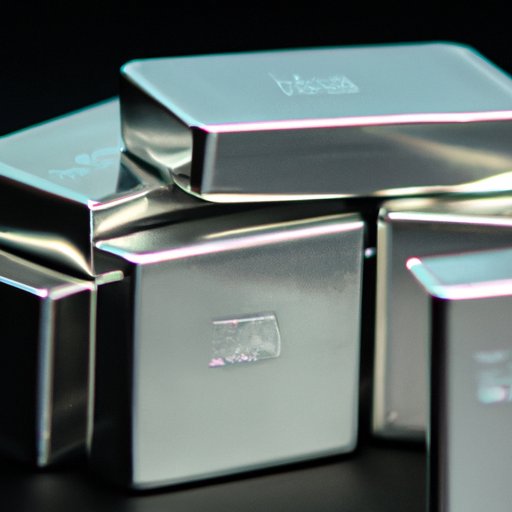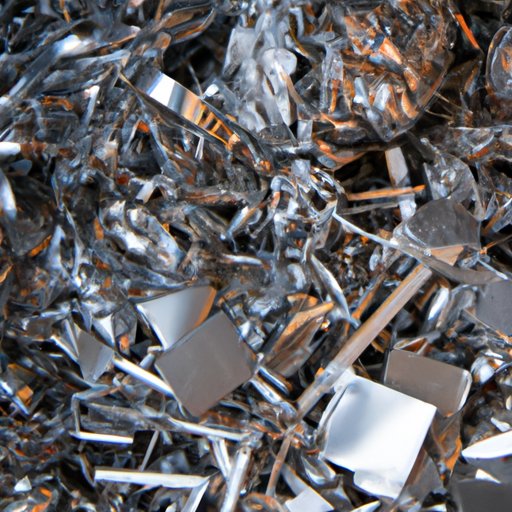Introduction
Aluminum is a lightweight, silver-white metal that is widely used throughout the world. It is abundant in nature and can be found in many forms. Aluminum has unique properties that make it an ideal material for a variety of applications. This article provides an in-depth exploration of the history, properties, and uses of aluminum.
What is Aluminum?
Aluminum is a chemical element with the symbol Al and atomic number 13. It is a silvery-white, soft, non-magnetic, and ductile metal in the boron group. Aluminum is the third most abundant element in the Earth’s crust (after oxygen and silicon) and the most abundant metal. It makes up about 8 percent of the Earth’s crust by mass.
History of Aluminum Production and Use
Aluminum was first produced in 1825 by Hans Christian Oersted, a Danish chemist. He heated anhydrous aluminum chloride with potassium amalgam, which yielded a lump of metal that he named “aluminum.” The production process was later improved upon by other chemists, including Henri Sainte-Claire Deville. In 1886, Charles Martin Hall and Paul Héroult independently developed the electrolytic process that is still used today to produce aluminum from bauxite ore.
In the late 19th century, aluminum became increasingly popular as an industrial material. It was used in the manufacture of aircraft, automobiles, and other products. By the mid-20th century, aluminum had become one of the most widely used metals in the world. Today, it is used in a wide range of products, from cars and airplanes to kitchen appliances and electronics.
Environmental Impact of Aluminum
The production of aluminum has significant environmental impacts. Aluminum smelting requires large amounts of energy, which can lead to air and water pollution. The mining of bauxite ore, which is the primary source of aluminum, can also cause environmental damage. Additionally, aluminum production creates hazardous waste, such as sulfur dioxide, carbon dioxide, and fluoride compounds.

Properties and Characteristics of Aluminum
Aluminum has several unique properties that make it an ideal material for many applications. It is lightweight, strong, corrosion-resistant, easily machined, and highly conductive of both heat and electricity.
Physical Properties
Aluminum is a lightweight metal with a density of 2.7 g/cm3, about one-third that of steel. It is malleable, ductile, and easy to work with. It has a melting point of 660.37°C (1220.66°F). Aluminum has excellent thermal and electrical conductivity, making it suitable for use in a variety of applications.
Chemical Properties
Aluminum is a reactive metal and does not occur naturally in its pure form. It must be extracted from bauxite ore using electrolysis. Aluminum is resistant to corrosion due to the formation of a protective oxide layer on its surface when exposed to air.
Uses of Aluminum
Due to its unique properties, aluminum is used in a wide variety of applications. It is commonly used in the construction, aerospace, automotive, and electronics industries. Aluminum is also used in the manufacture of kitchenware, packaging materials, and other consumer products.

Applications of Aluminum in Everyday Life
Aluminum is used in a variety of everyday products and applications. Here are some of the most common uses of aluminum:
Building and Construction
Aluminum is widely used in the building and construction industry. It is used in the manufacture of window frames, doors, roofing, siding, gutters, and other building components. Aluminum is also used in the production of insulation panels, pipes, and other materials.
Aerospace Industry
Aluminum is an ideal material for the aerospace industry due to its strength, light weight, and corrosion resistance. Aluminum is used in the construction of aircraft, spacecraft, missiles, and satellites.
Automotive Industry
Aluminum is used extensively in the automotive industry. It is used in the manufacture of car bodies, engine parts, and other components. Aluminum is also used in the production of tires and wheels.
Electronics
Aluminum is used in the manufacture of electronic components, such as capacitors and transformers. It is also used in the production of printed circuit boards.
Kitchenware
Aluminum is used in the manufacture of kitchen utensils, such as pots and pans. It is also used in the production of bakeware and other kitchen items.
Other Uses
Aluminum is also used in the manufacture of paint, foil, packaging materials, and other consumer products. It is also used in the production of sporting goods, such as baseball bats and golf clubs.
Recycling Aluminum
Aluminum can be recycled indefinitely without losing its properties. Recycling aluminum conserves energy and resources, reduces emissions, and helps to preserve natural resources. Additionally, recycled aluminum requires 95 percent less energy to produce than virgin aluminum.
Benefits of Recycling Aluminum
Recycling aluminum has numerous environmental benefits. It reduces air and water pollution, reduces greenhouse gas emissions, and conserves energy and resources. Additionally, recycling aluminum reduces the amount of waste sent to landfills.
How to Recycle Aluminum
Aluminum can be recycled at local recycling centers or scrap yards. It can also be recycled through curbside recycling programs. To ensure that aluminum is recycled properly, it should be separated from other materials before being placed in the recycling bin.
Conclusion
Aluminum is a versatile metal with a wide range of uses. It is used in the manufacture of building components, aerospace components, automotive components, and electronics. Aluminum is lightweight, strong, corrosion-resistant, and highly conductive of both heat and electricity. Additionally, aluminum can be recycled indefinitely without losing its properties. Recycling aluminum helps to conserve energy and resources, reduce emissions, and preserve natural resources.

